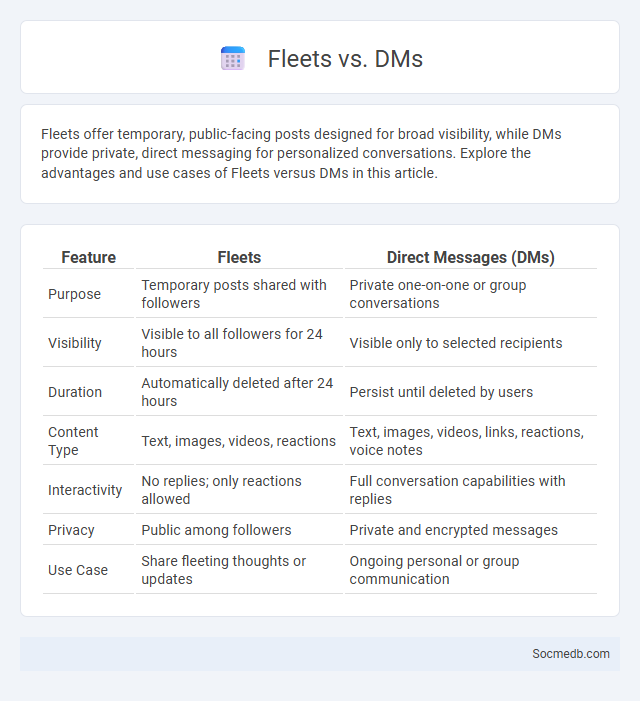
Photo illustration: Fleets vs DMs
Fleets offer temporary, public-facing posts designed for broad visibility, while DMs provide private, direct messaging for personalized conversations. Explore the advantages and use cases of Fleets versus DMs in this article.
Table of Comparison
| Feature | Fleets | Direct Messages (DMs) |
|---|---|---|
| Purpose | Temporary posts shared with followers | Private one-on-one or group conversations |
| Visibility | Visible to all followers for 24 hours | Visible only to selected recipients |
| Duration | Automatically deleted after 24 hours | Persist until deleted by users |
| Content Type | Text, images, videos, reactions | Text, images, videos, links, reactions, voice notes |
| Interactivity | No replies; only reactions allowed | Full conversation capabilities with replies |
| Privacy | Public among followers | Private and encrypted messages |
| Use Case | Share fleeting thoughts or updates | Ongoing personal or group communication |
Introduction to Fleets, DMs, and Their Differences
Fleets are temporary social media posts that disappear after 24 hours, providing users with a casual way to share thoughts or updates without permanent visibility. Direct Messages (DMs) offer private conversations between users, enabling one-on-one or group chats that remain accessible until deleted. Unlike Fleets, DMs focus on private communication, while Fleets encourage public, ephemeral interactions.
What Are Fleets?
Fleets are ephemeral posts on Twitter that disappear after 24 hours, designed to encourage more spontaneous and less permanent sharing. They allow users to share text, photos, videos, and reactions without the pressure of long-term visibility, increasing engagement among followers. By limiting the lifespan of content, fleets provide a casual way to express thoughts and updates, similar to Stories on other social media platforms.
Understanding Direct Messages (DMs)
Direct Messages (DMs) on social media platforms enable private communication between users, allowing for personalized and confidential interactions. Understanding DM features, such as read receipts, message requests, and multimedia sharing, enhances user engagement and privacy management. Efficient use of DMs supports customer service, networking, and community building without public exposure.
Key Features of Fleets
Fleets on social media offer ephemeral content that disappears after 24 hours, allowing you to share moments without permanent posts. They support text, photos, videos, and interactive stickers, enhancing engagement and storytelling. This feature encourages spontaneous sharing while maintaining your profile's clean, curated look.
Key Features of DMs
Direct Messages (DMs) on social media platforms provide private, real-time communication between users, enabling you to share texts, images, videos, and voice notes securely. Key features include read receipts, typing indicators, and the ability to create group chats for more dynamic interactions. Enhanced privacy settings and end-to-end encryption ensure your conversations remain confidential and protected.
Fleets vs DMs: Privacy and Security
Fleets on social media provide ephemeral content that disappears after 24 hours, offering limited privacy protection compared to Direct Messages (DMs), which ensure one-on-one communication with encrypted content for enhanced security. Fleets' temporary nature can reduce the risk of long-term data exposure but lack the robust encryption protocols found in DMs, making sensitive information more vulnerable. Users prioritizing privacy and security should prefer DMs for confidential conversations due to their stronger access controls and encryption standards.
Use Cases: When to Use Fleets or DMs
Fleets on Twitter are ideal for sharing ephemeral content, quick updates, or personal thoughts that disappear after 24 hours, engaging followers without cluttering the main feed. Direct Messages (DMs) facilitate private, one-on-one or group conversations, perfect for confidential discussions, customer support, or building deeper relationships with followers. Leveraging Fleets boosts real-time interaction and visibility, while DMs provide a secure channel for detailed, personalized communication.
Advantages and Disadvantages of Fleets
Fleets on social media offer a unique way to share temporary content that disappears after 24 hours, encouraging more spontaneous and less curated interactions. Your engagement can increase through Fleets by reaching followers who prefer ephemeral posts, but the downside includes limited visibility and the potential for messages to be overlooked quickly. While Fleets enhance casual communication, they lack permanence and detailed analytics compared to traditional posts, affecting long-term content strategies.
Advantages and Disadvantages of DMs
Direct messages (DMs) on social media offer a private communication channel that enhances personal connection, facilitates instant customer support, and enables targeted marketing campaigns. However, DMs can also lead to privacy concerns, increased exposure to spam or phishing attempts, and potential misunderstandings due to lack of non-verbal cues. Balancing the benefits of direct engagement with the risks of security and miscommunication is crucial for effective social media management.
Choosing the Right Communication Tool: Fleets vs DMs
Choosing the right communication tool on social media depends on the message's purpose and audience engagement. Fleets enable ephemeral sharing of brief updates or announcements visible for 24 hours, fostering casual, real-time interaction without permanent digital footprints. Direct Messages (DMs) provide private, personalized conversations ideal for in-depth discussions, customer support, or confidential exchanges, ensuring controlled and secure communication between users.
 socmedb.com
socmedb.com